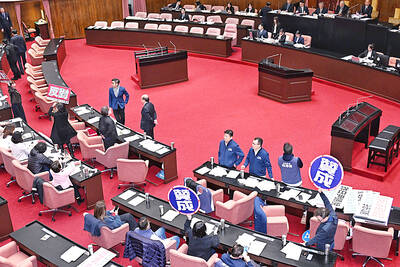The nation's long-awaited high speed railway began operation yesterday, marking a milestone in the nation's transportation history amid safety concerns and spotty ticketing service.
The new rail system service started with two trains departing from the line's northern stop in Banciao (板橋), Taipei County, and its southern stop in Tsoying (左營), Kaohsiung City, at 7am sharp.
Both trains traveled at a maximum speed of 300kph and arrived at their destinations at 8:30am, cutting normal train travel time by two-and-a-half-hours.
The section between Taipei and Banciao stations is still under construction. The high-speed rail service has been delayed since the end of October last year owing to problems with its core electrical system.
Undaunted by problems with the ticketing service because of a system malfunction, most passengers were excited to board the trains and satisfied with the ride.
"Despite some small problems, the situation remained under control [and we should be able] to solve [the problems] soon," Arthur Chiang (江金山), spokesman for Taiwan High Speed Rail Corp (THSRC, 台灣高鐵), the operator of the bullet train, said yesterday.
THSRC is in charge of operating the build-operate-transfer (BOT) railway project for 35 years before it is turned over to the government's control.
The company has been making surveys of passengers after each ride and has not yet received any major complaints, Chiang said.
Some passengers complained that they found their seats were already taken and were forced to take the next train.
THSRC announced on Thursday that it had found a glitch in the booking system that led to double bookings on 831 seats.
To solve the overbooking problem, THSRC provided an additional eight trains to carry those passengers, as well as offering each passenger a free ticket.
The company's solution has drawn criticism, however, as the Ministry of Transportation and Communications approved the operation of only 19 trains running in each direction per day.
Chiang defended the company's actions, saying the trains were needed to serve the needs of the 831 passengers and that the provisional dispatch was approved by the Bureau of High Speed Rail.
As THRSC had conducted intensive test-runs before the service's launch, the operation of the additional trains should not be a cause for concern, he said.
The company estimated that more than 30,000 people would be departing or arriving at the Banciao Station on the first day of its service.
The launch of the new railway system came amid numerous complaints over the past few days about ticket sales. To pacify consumers, THSRC said on Thursday that it would extend the half-priced fares until Jan. 19.
In Taichung, however, the service's launch was marred by conflict between representatives of a consumer advocacy group and an unidentified group of 20 people.
The group of 20 surrounded volunteers representing the Consumers' Foundation in the morning, snatching and destroying the posters and threatening them.
The foundation yesterday had dispatched volunteers and employees to the high-speed rail system's stations in Banciao, Taichung and Tsoying to advise passengers not to take the new transportation means before safety concerns were eased.
The conflict in Taichung nearly led to physical clashes, with a man in the Taichung station shouting at the foundation's representative: "Chinese dogs. Go back to China."
Foundation chairman Cheng Jen-hung (程仁宏) expressed regret over the protest, saying that it was a pity to see their "soft persuasion" efforts tainted by political color.
Cheng said that in consideration of its volunteers, the foundation would halt its on-site persuasion and launch a second-stage activity by collecting consumers' endorsement on the Internet.
"After gathering the public's opinions, we'll visit the Minister of Transportation and Communications soon to express our opinion and demand that the government clarify safety guarantee regulations for passengers," he said.
Still, the presence of a French driver, Patrick Poulenas, controlling the Japanese-designed bullet train yesterday reflected the checkered history of the project, first conceived in the 1990s and based on the Eurotrain of Alstom-Siemens. But in 1998 THSRC -- reportedly on the order of then-president Lee Teng-hui (
Poulenas and his 39 compatriots, along with 13 German drivers operate the trains, but THSRC hopes local drivers will replace them within 18 months.
Additional reporting by AFP
also see story:
Editorial: Here's to a safe rail system

A magnitude 7.0 earthquake struck off Yilan at 11:05pm yesterday, the Central Weather Administration (CWA) said. The epicenter was located at sea, about 32.3km east of Yilan County Hall, at a depth of 72.8km, CWA data showed There were no immediate reports of damage. The intensity of the quake, which gauges the actual effect of a seismic event, measured 4 in Yilan County area on Taiwan’s seven-tier intensity scale, the data showed. It measured 4 in other parts of eastern, northern and central Taiwan as well as Tainan, and 3 in Kaohsiung and Pingtung County, and 2 in Lienchiang and Penghu counties and 1

FOREIGN INTERFERENCE: Beijing would likely intensify public opinion warfare in next year’s local elections to prevent Lai from getting re-elected, the ‘Yomiuri Shimbun’ said Internal documents from a Chinese artificial intelligence (AI) company indicated that China has been using the technology to intervene in foreign elections, including propaganda targeting Taiwan’s local elections next year and presidential elections in 2028, a Japanese newspaper reported yesterday. The Institute of National Security of Vanderbilt University obtained nearly 400 pages of documents from GoLaxy, a company with ties to the Chinese government, and found evidence that it had apparently deployed sophisticated, AI-driven propaganda campaigns in Hong Kong and Taiwan to shape public opinion, the Yomiuri Shimbun reported. GoLaxy provides insights, situation analysis and public opinion-shaping technology by conducting network surveillance

‘POLITICAL GAME’: DPP lawmakers said the motion would not meet the legislative threshold needed, and accused the KMT and the TPP of trivializing the Constitution The Legislative Yuan yesterday approved a motion to initiate impeachment proceedings against President William Lai (賴清德), saying he had undermined Taiwan’s constitutional order and democracy. The motion was approved 61-50 by lawmakers from the main opposition Chinese Nationalist Party (KMT) and the smaller Taiwan People’s Party (TPP), who together hold a legislative majority. Under the motion, a roll call vote for impeachment would be held on May 19 next year, after various hearings are held and Lai is given the chance to defend himself. The move came after Lai on Monday last week did not promulgate an amendment passed by the legislature that

Taiwan is gearing up to celebrate the New Year at events across the country, headlined by the annual countdown and Taipei 101 fireworks display at midnight. Many of the events are to be livesteamed online. See below for lineups and links: Taipei Taipei’s New Year’s Party 2026 is to begin at 7pm and run until 1am, with the theme “Sailing to the Future.” South Korean girl group KARA is headlining the concert at Taipei City Hall Plaza, with additional performances by Amber An (安心亞), Nick Chou (周湯豪), hip-hop trio Nine One One (玖壹壹), Bii (畢書盡), girl group Genblue (幻藍小熊) and more. The festivities are to